As the seasons shift and the whispers of cultural festivities linger in the air, my culinary curiosities lead me down a path adorned with tradition and texture. I am Gobble, your gourmet guide here at Food and Meal, and today I am absolutely enchanted to share with you a recipe that wraps the essence of Japan in a savory, seaweed-clad delight: Norimaki Mochi.
Why do I find myself drawn to the intricate layers of Norimaki Mochi? It is a dish that tells a story, one where each chewy bite of mochi rice cake intertwines with the crisp, salty embrace of nori seaweed, creating a harmonious symphony that honors Japan’s ocean’s bounty and the comforting warmth of steamed glutinous rice.
In moments of reflection or celebration, there’s a profound solace to be found in preparing traditional foods that weave the threads of history into our present-day lives. Making Norimaki Mochi is akin to painting with flavors and textures, a ceremonious act of paying homage to time-honored customs while inviting new experiences to unfold within our modern kitchens.
This timeless snack captures my affection not only for its satisfying contrast in textures but also for its embodiment of simplicity and elegance. It’s a visceral reminder of how delightful bites often come in the most unassuming forms, and how food can serve as a bridge connecting us to lands and seas far away.
As you roll up your sleeves and accompany me on this culinary exploration, you will find more than just the pleasure derived from handcrafting these delectable rolls; you will uncover a world where each ingredient carries its own heritage, whispering tales of fields, oceans, and the hands that have shaped them through generations.
Japanese Norimaki Mochi Recipes
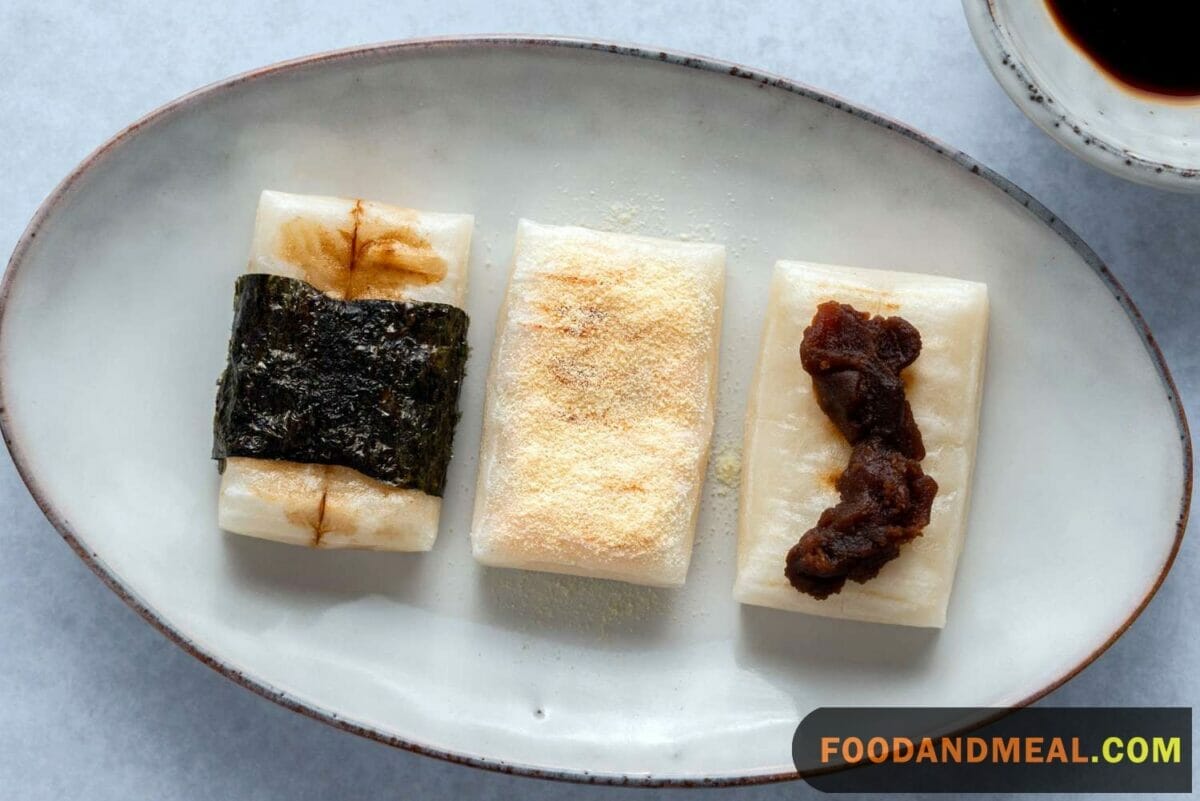
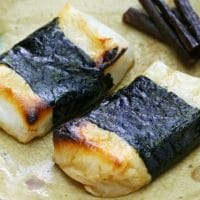
Norimaki Mochi
Equipment
Ingredients
Instructions
- Mix the soy sauce and white sugar in a small mixing bowl. Heat in a bowl until the sugar dissolves.
- Place the rice cake pieces in the microwave for twenty Minutes until soft.
- Coat the rice cake with soy sauce mixture then wrap the cakes in nori pieces.
- Serve and enjoy.
Video
Notes
Nutrition
© Food And Meal
This website provides approximate nutrition information for convenience and as a courtesy only. Nutrition data is gathered primarily from the Spoonacular Database, whenever available, or otherwise other online calculators.
Alternative Preparation Method: Grilling Norimaki Mochi
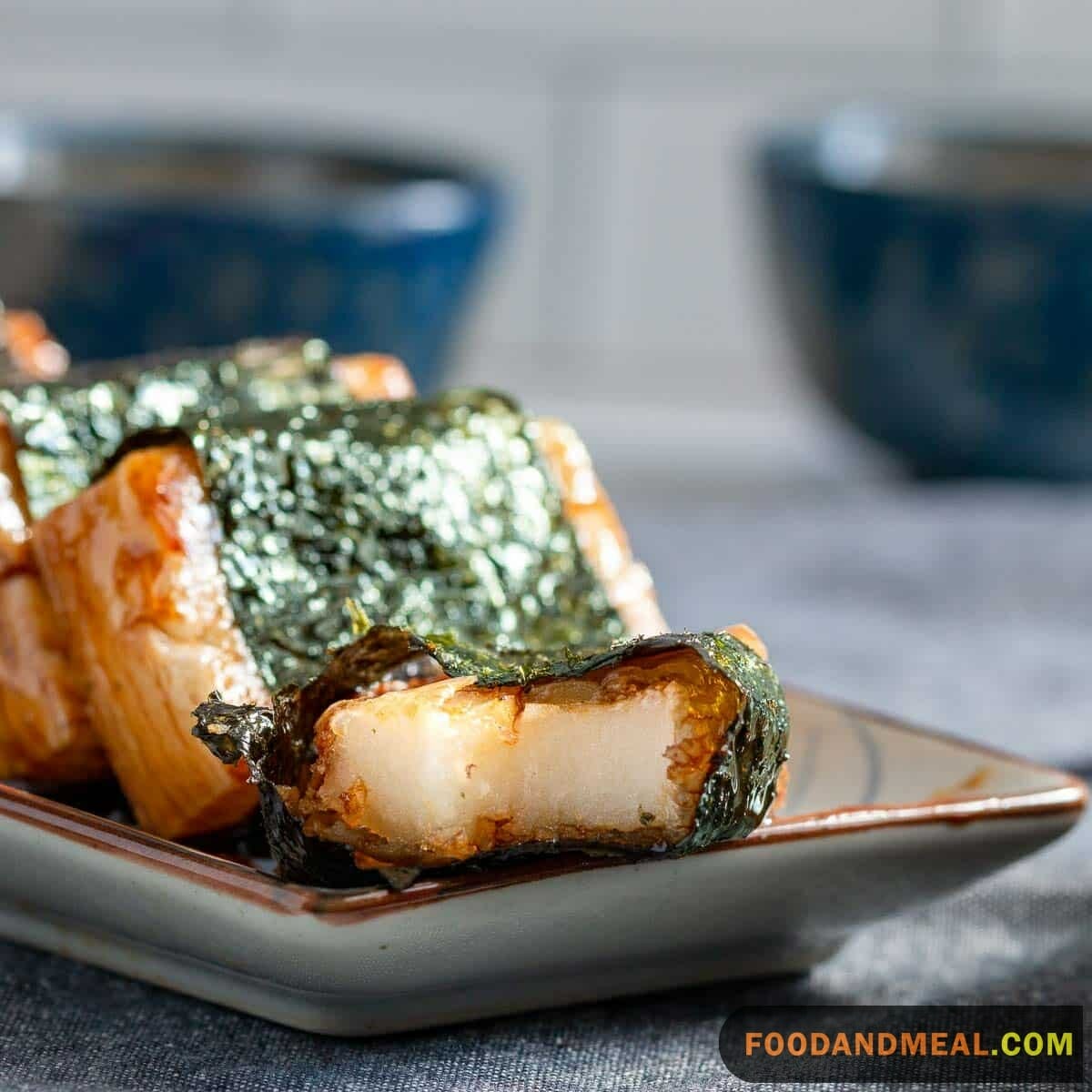
Grilling Norimaki Mochi introduces a delightful smokiness to this classic treat, elevating its flavor profile. Begin by preheating your grill to a medium-high temperature, ensuring it reaches around 350-400°F (175-200°C). Clean and lightly grease the grill grates to prevent sticking. As the grill heats up, carefully thread the Norimaki Mochi onto bamboo skewers that have been soaked. Each skewer can typically accommodate 2-3 rolls. Once the grill is ready, place the skewers on the grates with some space between them. Grill for 2-4 minutes per side, watching for the nori seaweed to crisp up and the mochi to develop a golden hue and soft texture. Avoid overcooking by keeping a close eye on the process. After grilling, let the Norimaki Mochi cool for a brief moment before serving. The result is a unique and smoky twist on this traditional dish, perfect for savoring the enhanced flavors brought out by the grill.
Pro Tips:
- Be cautious when grilling Norimaki Mochi, as they can cook quickly. Keep a close watch to ensure they don’t burn.
- If you like, you can lightly brush the Norimaki Mochi with soy sauce or a sweet glaze of your choice before grilling for added flavor.
Tips for making Norimaki Mochi
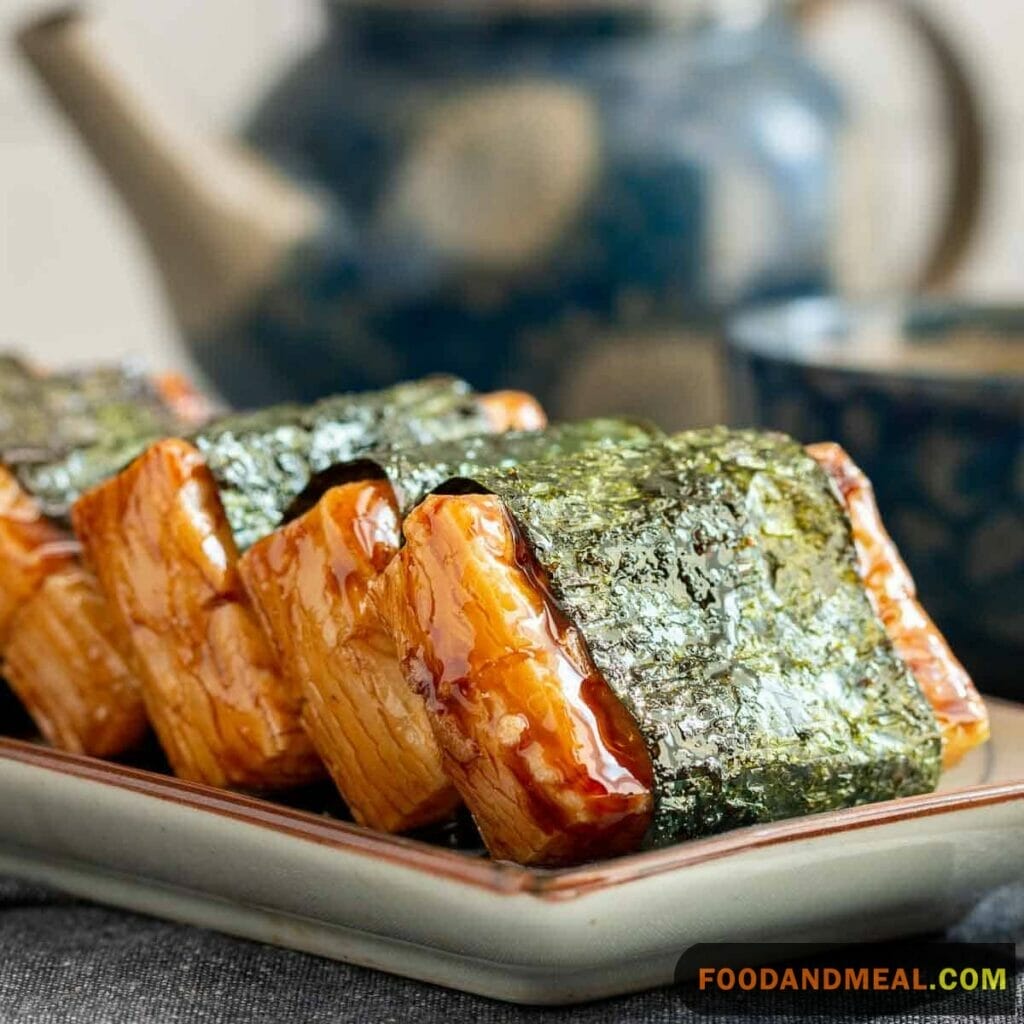
Cooking Tips
Norimaki Mochi, a delightful convergence of tradition and flavors, invites a unique culinary experience where the comforting chewiness of mochi meets the crisp, salty allure of nori seaweed. As you embark on the journey of crafting this dish, begin with the heart of the mochi—the right glutinous rice. Pay careful attention to its preparation, rinsing gently and steaming with patience, ensuring each grain is tender yet sticky, offering a soothing embrace to the soul. Nori, more than a mere wrapper, imparts an oceanic fragrance to each roll, creating a dance of textures when contrasted with the soft mochi. The art of rolling demands a delicate balance—firm yet careful hands, precise in molding each roll snugly without compromising the delicate rice. As you approach the emotional finish, cutting with confidence and a sharp knife ensures a clean, defined presentation, much like the final brushstroke on a canvas.
Serving Suggestions
Start by sipping on the comforting warmth of Butajiru, a miso-based pork and vegetable soup, whose umami-rich depths enhance the subtle tastes of rice and seaweed in the norimaki mochi. Follow this with a heartwarming Oyakodon bowl, where the salty-sweet combination of chicken and egg over rice beautifully contrasts with the mochi’s lightness. Delicate sashimi makes for an ideal precursor, creating a delightful interplay of textures and flavors. Serving the mochi alongside yaki udon provides a satisfying mix of savory stir-fried noodles with the muted tones of rice and seaweed. A bowl of shoyu ramen acts as a delicious prelude, setting the stage for the salt-kissed norimaki mochi. Norimaki mochi alongside the bold flavors of gyudon, a beef bowl, brings forth a delightful contrast in tastes. To elevate the experience, offer ponzu sauce for dipping, adding a citrusy burst that cuts through the mochi’s denseness.
Frequently Asked Questions about Norimaki Mochi
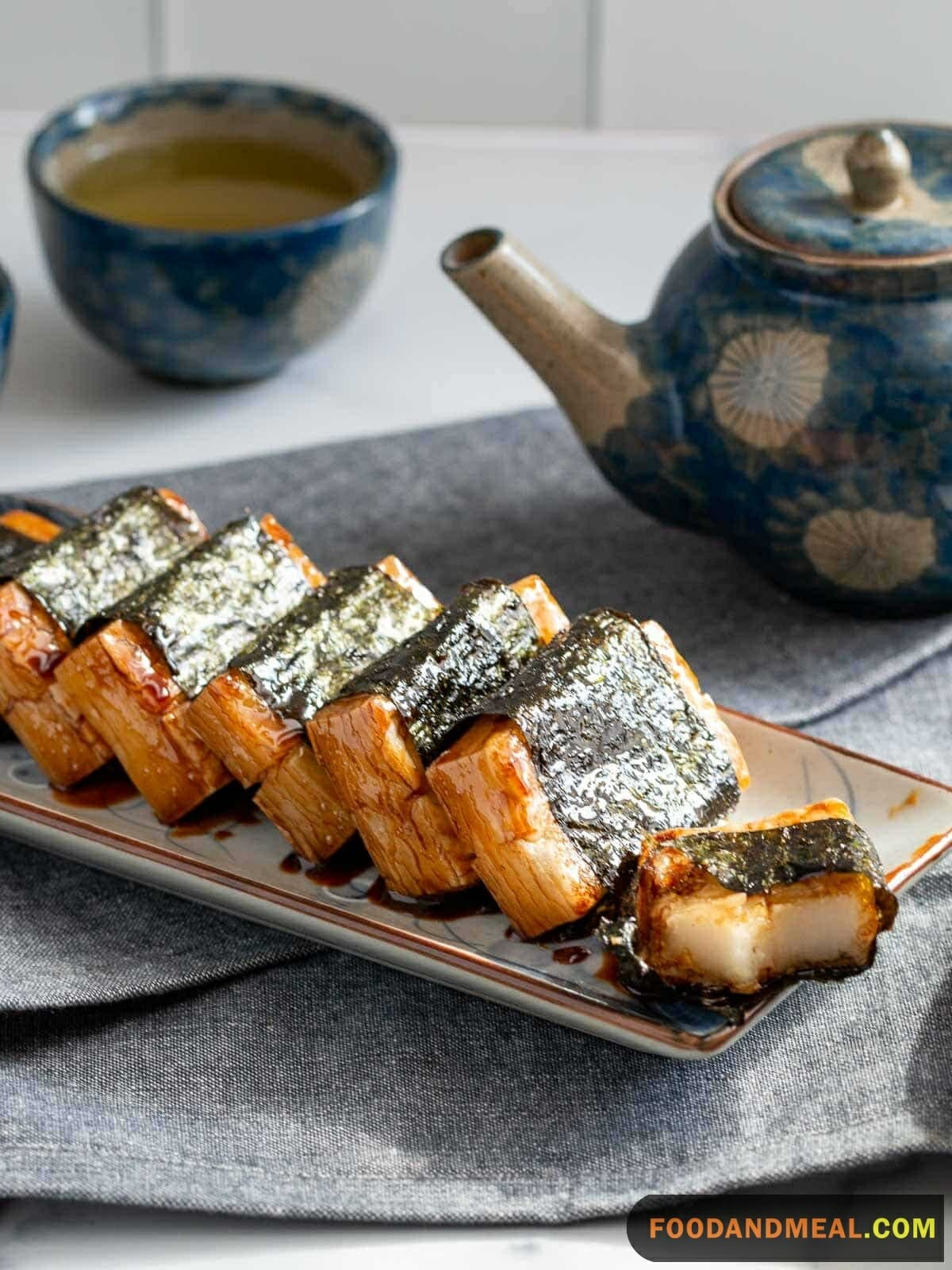
- Can I prepare Norimaki Mochi in advance for a party? Yes, you can prepare Norimaki Mochi in advance. However, to maintain the best texture, it’s recommended to wrap the rolls in plastic wrap or a damp cloth to prevent them from drying out. You can also grill or heat them just before serving for a fresh taste.
- Can I substitute mochi with another ingredient? Traditional Norimaki Mochi uses mochi rice cakes, but you can get creative and experiment with alternatives like tofu or sweet potato. These substitutions can cater to dietary preferences and add unique flavors.
- Is it essential to use bamboo skewers for grilling? While bamboo skewers are commonly used, you can also use metal skewers for grilling Norimaki Mochi. The key is to prevent them from burning by soaking wooden skewers for at least 30 minutes.
- How do I store leftover Norimaki Mochi? If you have any leftovers, store them in an airtight container in the refrigerator. Reheat them in a microwave or a quick pan-fry to refresh the texture before serving.
Conclusion
As we bring our exploration of the delightful Japanese Norimaki Mochi to a close, a feeling of satisfaction and cultural reverence fills the air. Together, we have journeyed through the art of wrapping chewy steamed mochi with crisp nori, creating a delicacy that resonates with the beauty of simplicity and the depth of tradition.
Here at Food and Meal, it has been an honor to guide you through this recipe, infusing each step with personal insights and the shared joy of discovery. As your humble narrator, I have endeavored to illuminate not just the method but the emotion woven into the fabric of this time-honored treat. These mochi rolls are more than a mere confection; they are an experience, a connection to a culinary heritage that stands proud amidst the tides of time.
Through the pages of foodandmeal.com, we’ve captured the essence of Norimaki Mochi, celebrating its understated elegance and the harmonious contrast between the mochi’s softness and the nori’s saltiness. May this post be not only a recipe for your archives but also a memory to cherish—a moment spent crafting, learning, and perhaps even starting new traditions within your own kitchen.
Whether shared amongst friends or enjoyed quietly with a cup of tea, the Norimaki Mochi is a testament to how food can transcend langue and culture, becoming a universally appreciated gesture of hospitality and warmth. As you part from this post, take with you the understanding that each roll, each bite, tells a story of lands afar and the simple joy that cooking with heart brings.
We bid you farewell, not as the end, but as an invitation to return to us at Food and Meal whenever the urge to immerse yourself in the world of flavors and aromas calls you back. For recipes like these and many more gastronomic adventures, we will always be here, ready to share the love of cooking and the stories behind every dish.
Hi! I’m Paula from the Philippines, the passionate blogger and skilled photographer behind Gobble the Cook. I also spearhead the media photography for Food And Meal in Vietnam.


